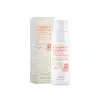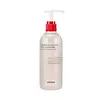What's inside
What's inside
 Key Ingredients
Key Ingredients

 Benefits
Benefits

 Concerns
Concerns

 Ingredients Side-by-side
Ingredients Side-by-side

Sodium Cocoyl Isethionate
CleansingSodium Lauroyl Glutamate
Coconut Acid
CleansingSodium Isethionate
CleansingWater
Skin ConditioningSodium Bicarbonate
AbrasiveZea Mays Starch
AbsorbentCalamine
AbsorbentHouttuynia Cordata Extract
Skin ConditioningLaminaria Japonica Extract
Skin ProtectingCentella Asiatica Extract
CleansingSodium Polyacrylate
AbsorbentSucrose
HumectantAscorbic Acid
AntioxidantSodium Hyaluronate
HumectantCentella Asiatica Leaf/Stem Powder
Protease
ExfoliatingBromelain
Skin ConditioningSea Salt
AbrasiveGlycerin
HumectantHydrogenated Phosphatidylcholine
Emulsifying1,2-Hexanediol
Skin ConditioningCaprylic/Capric Triglyceride
MaskingButylene Glycol
HumectantAsiaticoside
AntioxidantMadecassic Acid
Skin ConditioningAsiatic Acid
Skin ConditioningMadecassoside
AntioxidantSucrose Stearate
EmollientCetearyl Alcohol
EmollientSodium Cocoyl Isethionate, Sodium Lauroyl Glutamate, Coconut Acid, Sodium Isethionate, Water, Sodium Bicarbonate, Zea Mays Starch, Calamine, Houttuynia Cordata Extract, Laminaria Japonica Extract, Centella Asiatica Extract, Sodium Polyacrylate, Sucrose, Ascorbic Acid, Sodium Hyaluronate, Centella Asiatica Leaf/Stem Powder, Protease, Bromelain, Sea Salt, Glycerin, Hydrogenated Phosphatidylcholine, 1,2-Hexanediol, Caprylic/Capric Triglyceride, Butylene Glycol, Asiaticoside, Madecassic Acid, Asiatic Acid, Madecassoside, Sucrose Stearate, Cetearyl Alcohol
Water
Skin ConditioningGlycerin
HumectantPotassium Cocoyl Glycinate
Lauryl Betaine
CleansingC12-14 Pareth-12
EmulsifyingLauryl Hydroxysultaine
CleansingDisodium Cocoamphodiacetate
Cleansing1,2-Hexanediol
Skin ConditioningAcrylates/C10-30 Alkyl Acrylate Crosspolymer
Emulsion StabilisingSodium Chloride
MaskingParfum
MaskingBetaine
HumectantSalicylic Acid
MaskingPanthenol
Skin ConditioningHydroxyacetophenone
AntioxidantMenthol
MaskingDisodium EDTA
Ethylhexylglycerin
Skin ConditioningButylene Glycol
HumectantMentha Arvensis Leaf Extract
MaskingMadecassic Acid
Skin ConditioningAsiaticoside
AntioxidantAsiatic Acid
Skin ConditioningWater, Glycerin, Potassium Cocoyl Glycinate, Lauryl Betaine, C12-14 Pareth-12, Lauryl Hydroxysultaine, Disodium Cocoamphodiacetate, 1,2-Hexanediol, Acrylates/C10-30 Alkyl Acrylate Crosspolymer, Sodium Chloride, Parfum, Betaine, Salicylic Acid, Panthenol, Hydroxyacetophenone, Menthol, Disodium EDTA, Ethylhexylglycerin, Butylene Glycol, Mentha Arvensis Leaf Extract, Madecassic Acid, Asiaticoside, Asiatic Acid
 Reviews
Reviews

Ingredients Explained
These ingredients are found in both products.
Ingredients higher up in an ingredient list are typically present in a larger amount.
1,2-Hexanediol is a synthetic liquid and another multi-functional powerhouse.
It is a:
- Humectant, drawing moisture into the skin
- Emollient, helping to soften skin
- Solvent, dispersing and stabilizing formulas
- Preservative booster, enhancing the antimicrobial activity of other preservatives
Asiatic Acid is a major component of Centella Asiatica Extract. It has wound-healing, anti-inflammatory, and antioxidant properties.
Studies show Asiatic Acid is able to block the pathway for skin inflammation receptors, helping to soothe skin.
As an antioxidant, asiatic acid helps protect our skin against damaging environmental factors.
Learn more about Asiatic AcidAsiaticoside comes from the super popular skin-soothing ingredient, Centella asiatica. It is one of four active compounds found in the extract of Centella Asiatica.
Asiaticoside is an antioxidant and helps with wound healing. It has been shown to increase antioxidant activity during the wound healing process.
Butylene Glycol (or BG) is used within cosmetic products for a few different reasons:
Overall, Butylene Glycol is a safe and well-rounded ingredient that works well with other ingredients.
Though this ingredient works well with most skin types, some people with sensitive skin may experience a reaction such as allergic rashes, closed comedones, or itchiness.
Learn more about Butylene GlycolGlycerin is already naturally found in your skin. It helps moisturize and protect your skin.
A study from 2016 found glycerin to be more effective as a humectant than AHAs and hyaluronic acid.
As a humectant, it helps the skin stay hydrated by pulling moisture to your skin. The low molecular weight of glycerin allows it to pull moisture into the deeper layers of your skin.
Hydrated skin improves your skin barrier; Your skin barrier helps protect against irritants and bacteria.
Glycerin has also been found to have antimicrobial and antiviral properties. Due to these properties, glycerin is often used in wound and burn treatments.
In cosmetics, glycerin is usually derived from plants such as soybean or palm. However, it can also be sourced from animals, such as tallow or animal fat.
This ingredient is organic, colorless, odorless, and non-toxic.
Glycerin is the name for this ingredient in American English. British English uses Glycerol/Glycerine.
Learn more about GlycerinMadecassic Acid is a major component of Centella Asiatica Extract. It has anti-inflammatory and antioxidant properties.
It is a triterpenoid, meaning it naturally acts as an antioxidant. Antioxidants protect your skin against damage from environmental factors such as pollution and UV.
Studies show Madecassic Acid helps soothe the skin due to its ability to block inflammation pathways.
Learn more about Madecassic AcidWater. It's the most common cosmetic ingredient of all. You'll usually see it at the top of ingredient lists, meaning that it makes up the largest part of the product.
So why is it so popular? Water most often acts as a solvent - this means that it helps dissolve other ingredients into the formulation.
You'll also recognize water as that liquid we all need to stay alive. If you see this, drink a glass of water. Stay hydrated!
Learn more about Water